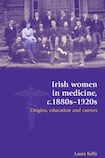
In 2008 three-quarters of Irish medical students were women, giving rise to panic about the “feminisation of medicine”. It came as a shock to some people that girls not only could do better in the Leaving Certificate than boys but also might choose careers in medicine with their resulting high points. Then what happens? They have babies and require family-friendly working conditions, something never needed by their male forebears because they had wives, many of whom acted as unpaid secretaries and receptionists while also rearing families. Strangely, none of the panic-stricken commentators suggests that the husbands of female doctors should take up family responsibilities, freeing their spouses for their professional work.
The Health Professions Admission Test – Ireland system was introduced in 2009 to try to even the gender playing pitch by requiring an interview focusing on skills other than the academic before admission to medical school. It turns out, after an initial gain by males, that the girls are better at that, too.
In 1898, 0.8 per cent of medical students in Ireland were women, very different from today’s situation. Laura Kelly’s book on Irish women in medicine covers the early years of women’s admission to medical schools and their experiences as students and qualified doctors. She has created an extremely useful database of the 452 women who qualified between 1885 and 1922, which she has exploited to come to interesting statistical conclusions about her cohort of pioneering women physicians, in terms of class and religious backgrounds, careers, marital status (where available) and migration. She is completely transparent about her source material, and cognisant of its shortcomings in some respects.
The first, and therefore the most interesting, institution to admit women as applicants for licences to practice medicine was the King and Queen's College of Physicians of Ireland – now the Royal College of Physicians of Ireland – where the governing council decided on this groundbreaking step in 1877. The Queen's Colleges and the Royal College of Surgeons allowed women to take medical degrees from the mid 1880s, the Catholic University in 1898, Trinity College Dublin not until 1904. All of these were well in advance of their British counterparts, which leads Kelly to argue that hostility to women in Irish third-level institutions has been exaggerated, at least in the case of medicine, and that a tolerant, liberal attitude towards female students prevailed in Irish medical schools and hospitals.
This may well be so – their alacrity in admitting female students seems to bear the thesis out – but Kelly has hardly any material at her disposal to prove what motivated the male establishment to behave in the way it did. Some of this, of course, is down to the paucity of discussion in the minutes of most organisations, and a seeming lack of correspondence or publication on the subject from the key players. This can’t be helped, but it’s a shame.
Kelly has to make do with a page of clever speculation, for example, on the possible motivations of Samuel Houghton, leading light of the council of the the King and Queen’s College of Physicians of Ireland, who had earlier broadened membership to include professors who were other than Protestant or British, and who was an undoubted liberal reformer. But she cannot quote a single sentence from him, or any of her other prime movers, on the subject of the admission of women to their medical schools. Primary sources are capricious, however, and the very thing you want is likely to be the thing you can’t find. Kelly is on strong ground in terms of actions; it would be terrific to have words as well.
The core of the book is Kelly’s examination of a number of early women medical graduates, starting with Emily Winifred Dickson, who graduated from the Royal College of Surgeons in 1892, had a highly successful career interrupted by marriage and children, played her part in suffrage and philanthropic organisations, and worked in the areas of gynaecology, mental health and general practice. She also, mercifully, left some correspondence and publications, which Kelly was intrepid enough to track down, so we get her contrasting views on marriage and professional life for women in the year of her own marriage, 1899. Before her marriage she thought that wives giving up work would “lower the status of the married state”; afterwards that “marriage and motherhood will always be the most important professions a woman can engage in”.
Kelly's conclusions point to further areas of research, all of which will be helped by her painstaking assembly of material never brought together before. As she points out, we still have no real history of male medical students in Ireland, never mind a statistical account of them as sophisticated as hers. One of the areas that would be interesting to pursue, suggested by Kelly, is the interaction between female medical students and graduates and the suffrage movement. We know a lot about Mary Strangman and Lucy Smith, but there must have been more, and given the deference shown to doctors in Ireland, then and now, these women would have been powerful advocates for their causes.
Laura Kelly has made a meticulously researched, well-written and important contribution to the history of Irish women and Irish medicine. Others will build on her foundations to explore further themes. A plea to Manchester University Press: bring down your prices, and allow a greater readership access to books such as this one.
Catriona Crowe is head of special projects at the National Archives of Ireland and a former president of the Women’s History Association.









